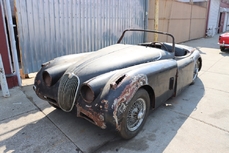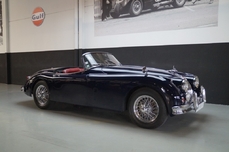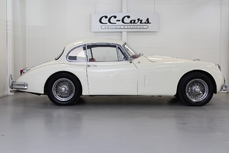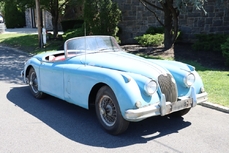Jaguar XK150 Drop Head Coupe 1959
General description :
Upon its introduction in the spring of 1957, Jaguar’s latest iteration of the XK-series got off to a slightly bumpy start. First, the factory fire that famously destroyed the remaining XKSS chassis also caused significant delays in the production of the new XK150. Once the earliest XK150 models reached the hands of testers, some complained about the car’s performance feeling rather blunt. While there were numerous mechanical improvements, including the addition of four-wheel disc brakes, the more substantial body caused it to be nominally slower than the outgoing XK140. Jaguar quickly addressed the issue by adding the Special Equipment package to the options list, which effectively became the new base model. The package included the B-Type cylinder head and dual exhaust, boosting performance enough to satisfy buyers and help the XK150 live up to its stylish new looks.
Like the XK140 before it, Jaguar offered the XK150 as a fixed head coupe, drophead coupe, and (from mid-1957) open-two-seat roadster. Beyond the pure aesthetic updates, the taller, slab-sided body allowed for a wider and substantially more comfortable cockpit, finally addressing a long-running complaint among XK owners. Leather and “Vynide” trim on the dash replaced the traditional burl wood trim of earlier models for a fresher and more modern appearance. With the initial hurdles behind it, the XK150 sold quite well, capitalizing on its Le Mans-winning pedigree. The success of the XK150 variants sustained Jaguar’s position the sharp end of the sports car market, even in the face of increasing competition from America and elsewhere, setting the stage for the XK’s sensational replacement, the E-Type, in 1961.
This lovely XK150 features the versatile and attractive Drophead Coupe coachwork and is presented with a beautiful, well-maintained restoration and subtle updates including a 5-speed gearbox to improve performance and drivability. The Jaguar Daimler Heritage Trust Certificate shows this car was completed on October 22, 1958, finished in Carmen Red over a red interior, and equipped with the 3.4-liter engine and Borg Warner transmission. It presents today in excellent condition, wearing a well-maintained restoration in the original shade of red over a biscuit interior and fawn canvas top. The body and paintwork are older, yet crisp and well-presented, displaying properly fitted panels with even, consistent gaps. The car rides on sparkling chrome wire wheels shod with high-performance, period-correct Michelin X radials. The remaining brightwork on the bumpers and body is in good order, with some fading and minor pitting evident, but with an overall consistent appearance that suits the car’s driver-friendly nature.
Inside, biscuit upholstery provides a lovely complement to the bright red paintwork. The seats are in excellent order, showing just the slightest creasing from use. Carpets, door cards, and interior panels feature correct style material, all presented in excellent condition. The instrument panel has attractive burl maple veneer and Vynide trim, and houses restored Smiths gauges, proper switchgear, and a period-correct radio. With its larger, fully-lined soft top and more luxurious trim, the drophead coupe nicely balances the opulent environment of the fixed head coupe with the open-air excitement of the roadster. Accompanying the sale are several items, including the tool kit, jack, grease gun, owner’s manual, and service manuals.
Beneath the bonnet sits the original 3.4-liter inline-six with numbers-matching block and head per the heritage certificate. The twin-cam unit is one of the most iconic engines ever produced, with its signature polished alloy cam covers and S.U. carburetor bodies. The engine is well detailed with a tidy, honest presentation befitting its tour-ready quality. Highlights include excellent black-porcelain exhaust manifolds with correct brass hardware and good quality polish work on the alloy. As previously stated, a five-speed manual gearbox replaces the cumbersome original Borg-Warner automatic, drastically improving this car’s performance and fun-factor. Additionally, powerful Wilwood brake calipers on the front axle provide a welcome upgrade for spirited motoring.
Combining a luxuriously trimmed cabin, full folding soft top, and proven underpinnings, the XK150 is arguably the most versatile and usable model in the entire XK series. Featuring a well-maintained restoration and thoughtful mechanical upgrades, this example of Jaguar’s superb grand tourer is ideally suited for enthusiastic touring, rallies, and regular enjoyment on your favorite roads.
Offers welcome and trades considered
https://hymanltd.com/vehicles/6651
1959 Jaguar XK150 Drop Head Coupe is listed sold on ClassicDigest in St. Louis by Mark Hyman for $129500.
Car Facts
Car type : Car Make : Jaguar Model : XK150 Model Version : Drop Head Coupe Engine size : 0.0 Model Year : 1959 Sub type : Coupé Location : Missouri
Sold
Seller Information
Sold
People who viewed this Jaguar XK150 also viewed similar Jaguar listed at ClassicDigest
Other cars listed for sale by this dealer
About Jaguar
Ah, the story of Jaguar, from its early days as the SS Cars Ltd. to its pinnacle with the D-type, and the street-going evolution in the form of the iconic E-type. There's something quintessentially British about this tale, and I'll narrate it as a British journalist might.In the Beginnings:
Our journey into the world of Jaguar begins in the 1930s, when a company known as SS Cars Ltd. emerged. Despite the unfortunate coincidence of their initials with the rising political tensions in Europe, they started producing stylish and performance-oriented cars. The SS 100, introduced in 1936, was a symbol of elegance and speed, setting the stage for what would become Jaguar.
The Birth of Jaguar:
As the shadows of World War II loomed, SS Cars Ltd. wisely decided to disassociate themselves from the SS initials. Thus, in 1945, they officially became Jaguar Cars Ltd., a name that would soon be synonymous with British luxury and performance.
The XK Series:
Jaguar's post-war era brought us the XK 120, a true sensation in 1948. With its sleek design and a powerful 3.4-liter inline-six engine, it became the world's fastest production car. The XK 120 was the blueprint for what lay ahead – Jaguars that blended style with speed in a uniquely British fashion.
The D-type Dominance:
Then came the D-type, a true racing legend. Introduced in 1954, it won Le Mans three times in the 1950s, showcasing Jaguar's engineering prowess. With its innovative monocoque construction and the iconic fin at the back, the D-type was the apex of Jaguar's motorsport success.
The E-type Emergence:
But the true turning point arrived in 1961 with the introduction of the E-type, often described by Enzo Ferrari as "the most beautiful car ever made." Its long bonnet, curvaceous body, and a 3.8-liter engine delivering exhilarating performance made it an instant classic. The E-type was not just a car; it was a work of art on wheels, and it could hit 150 mph on the road.
Street and Racing Success:
The E-type's beauty was matched by its capability on the track. The lightweight E-types were particularly successful in various racing events, cementing Jaguar's reputation as a force to be reckoned with in motorsport.
The Age of Refinement:
As we delve deeper into the Jaguar story, we find that the 1950s and 1960s were an age of refinement and expansion. Alongside the magnificent D-type and the E-type's iconic emergence, Jaguar introduced models that further solidified its reputation for luxury and performance.
The MK2:
In the late 1950s, Jaguar unveiled the MK2, a sports sedan that combined elegance with power. This sleek four-door saloon was a favorite of bank robbers and law enforcement alike, thanks to its exceptional speed and handling. The MK2 was a symbol of Jaguar's ability to blend sophistication with performance and had a successful racing career as well.
The XJ6:
Fast forward to 1968, and Jaguar launched a car that would define luxury saloons for decades to come – the XJ6. It was a masterpiece of engineering and design, featuring a smooth inline-six engine, independent rear suspension, and a spacious, beautifully appointed interior. The XJ6 was a symbol of British elegance and provided a ride so smooth that it seemed to glide over the road. It became the flagship model for Jaguar and set the standard for luxury saloons, showcasing a level of refinement that left competitors in awe.
The Blend of Classic and Modern:
While the MK2 and XJ6 represented the evolution of Jaguar's saloon cars, they maintained the brand's commitment to performance and luxury. These cars didn't just belong on the racetrack; they were equally at home cruising down the grand boulevards or gliding through the English countryside.
The Challenges of Change:
However, as the 1970s arrived, Jaguar, like many British automakers, faced financial challenges and changes in ownership. The British Leyland era brought both opportunities and struggles, as the brand navigated through various mergers and transitions.
Nevertheless, the legacy of the MK2 and XJ6, along with the D-type and E-type, continues to define Jaguar as a manufacturer that combines timeless elegance with a spirit of performance. These classic models, whether driven on winding roads or parked as collectors' treasures, serve as a testament to Jaguar's enduring presence in the world of automotive excellence.
The Jaguar story, from its early days as SS Cars Ltd. to the creation of automotive icons like the E-type, MK2, and XJ6, is a journey that reflects the very essence of British motoring – a blend of luxury, power, and style that continues to captivate enthusiasts and connoisseurs alike.











